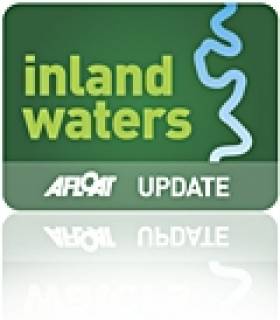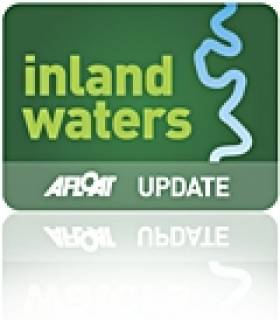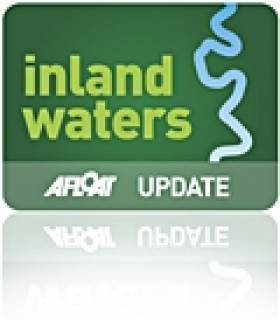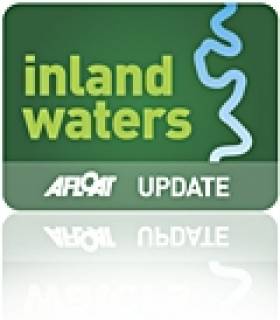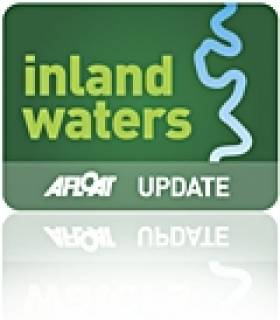Displaying items by tag: Waterways
A truly amazing gathering will take place this weekend in the historic town of Inistioge. It is unlikely that circumstances will conspire to facilitate a similar event for many years, so this is definitely a weekend 'not to be missed'. Heritage cargo boats will sail up the Nore valley on a rising tide from New Ross as they did for hundreds of years before the road and rail networks made them redundant. Their destination is Inistioge, the venue for the Inistioge Vintage Rally, and it is here that the boats will rub shoulders, or should that be wheels and fenders, with the mighty machines at the Vintage Rally.
The Irish Vintage Society (IVS), the Heritage Boat Association (HBA) and the Inland Waterways Association of Ireland (IWAI) confirmed today that a combined gathering of vintage cars, heritage boats and other boats will take place in Inistioge over the weekend commencing Saturday July 30th. HBA and IWAI boats will arrive in the morning and the vintage cars in the early evening. John Madden, President of the IVS, will escort the cars through the village at 18:30 with his bagpipes.
On Sunday, starting at 10.00 vintage cars, tractors, oil engines and mills will be on display with live music and dancing and a selection of stalls. Presentation of the Leslie Rothwell Trophy for the Best Vintage Exhibit will take place. Children's activities will include the Duck Derby on the canal and the ever popular Dog Show. Down by the river on both Sunday and Monday there will be the opportunity to view the history of the heritage boats and the site for the proposed Inistioge Moorings.
The HBA's Three Sister Fleet is celebrating the 220th anniversary of the Barrow Navigation, which when first created linked the Grand Canal with the rivers Barrow, Nore and Suir and opened up a large area of the hinterland to the ports of Dublin and Waterford. In the Fleet are two barges, 68M and 72M that in their earlier lives carried cargoes along Irish rivers, lakes and canals.
The HBA, the IVS and the IWAI welcome this opportunity to work with the local community highlighting the village, the fabulous River Nore and the campaign to enhance the Inistioge area with safe moorings and boating amenities.
Sunken Vessel Presents Hazard on the Shannon
It is intended to lift this vessel using a pontoon and lifting equipment on Thurs 30 Jun 2011, commencing at 08.00hrs. It is expected that the operation will take four hours. Masters should expect to be delayed when passing through the area.
All vessels passing the pontoons should exercise due caution and heed the advice and instructions of the safety boat in attendance.
Southbound vessels in particular should be aware of their speed as they approach the navigation arch with the attending flow in order to avoid a close quarters situation with the pontoon. Use of extra fenders in the bow area of vessels would be a prudent precautionary measure when passing the lifting rig.
12 Teams to Battle it out at First Inter-County Champs
The following is the list of counties, club (where applicable) and the skipper/helm of the teams formally entered to date.
|
Mayo |
Mayo Sailing Club |
Justin Cullen & Co |
|
Wicklow |
|
Tim Greenwood & Co |
|
Limerick |
Foynes Yacht Club |
Donal Mc Cormack & Co |
|
Dublin West |
Defence Forces |
Mick Liddy & Co |
|
Galway |
|
Fergal O'Flaherty & Co |
|
Donegal |
Lough Swilly Yacht Club |
Stephen Doherty & Co |
|
Dublin |
National Yacht Club |
Adam Winkelmann & Co |
|
Clare |
Royal Western Yacht Club |
Martin McNamara & Co |
|
Wexford |
Wexford Harbour Boat & Tennis Club |
Ben Scallan & Co |
|
Down |
Royal Northern Ireland Yacht Club & Dublin Bay Sailing Club |
John Mc Donald / Ruan O Tiarnaigh & Co |
Further entries expected, include a team from Offaly and rumour has it an all girl team led by a prominent female sailor from Dublin.
The organisers are delighted to have the support of the Irish Sailing Association and will use 8 of the Sailfleet J80’s for racing.
The championship will comprise a series of elimination flights (heats) to take place on Sunday 26th June from 1100hrs – 1500hrs, with the final taking place between 1500 – 1600hrs to decide the first Waterways Ireland Inter-Counties Sailing Champions.
To compliment the sailing event, the Docklands Business community are staging the Docklands Summer Festival, to run on Saturday and Sunday 25/26th June, with all kinds of watersports activities & try it sessions including; windsurfing, Stand Up Paddle Boarding, Kayaking, Peddle Boats, Barge Trips, Hire Boat Display, Plurabelle Paddlers Dragon Boat Display, plus markets, street entertainment, more details of which can be seen at www.docklandssummerfestival.com
The sailing event is sponsored by Waterways Ireland, an all island body set up to manage & promote all of Ireland’s waterways.
New Wheelyboat Makes Lough Rynn More Accessible
Leitrim Guardian Person of the Year Brendan Harvey was on hand to launch Lough Rynn's new Wheelyboat last weekend, the Leitrim Observer reports.
The boat is specially designed to meet the needs of people with disabilities in the area, giving them greater access to Leitrim's lakes and inland waterways for fishing or pleasure trips.
Built in England by registered charity the Wheelyboat Trust, the project was initiatied the Leitrim Association of People with Disabilities (LAPWD), with help from the Rinn-Shannon Agling Club.
The boat, named Ernest's Pride, is so called in tribute to Ernest Catherines, a "driving force" behind the scheme who passed away last month.
Celebrating the Three Sisters Navigation
This year we celebrate the 220th anniversary of the opening of the Barrow Navigation. This linked the Grand Canal with the rivers Barrow, Nore and Suir, and opened up a large area of the hinterland to the great ports of Dublin and Waterford. When the canals closed to commercial traffic in the 1960s it was feared that all use of the navigation would soon cease. Indeed, non-commercial traffic did become very light, but now, following excellent remedial works by Waterways Ireland we welcome a new era for this navigation, one which will bring new life and vitality to the waterway in the towns and villages along the system.
A hundred years ago, 1,200 boatmen were engaged in the business of transporting cargo, connecting people in inland towns with those in Irish ports, and in turn linking them with the great sea ports of the world. Today, many of their descendants live along our inland navigations.
Three of these great canal boats, numbers 72M, 68M and 107B, escorted by a flotilla of other HBA boats will, over the next few months, travel the entirety of the Navigation including Carlow, Waterford, Carrick on Suir, Inistioge and all points in between. The crews are anxious to meet with those whose families had connections with the commercial trade along the waterway, and perhaps even re-unite some long retired boatmen with their old boat.
The following are the expected arrival dates in various locations over the next few weeks:
° Carlow April 9th from 14.00
° Leighlinbridge April 16th from 14.00
° Bagenalstown April 24th from 13.00
Masters are requested by Waterways Ireland to give the parade a wide berth if not participating in it and to proceed at slow speed and with minimum wash when passing and to heed any advice offered by parade marshals.
New Project to Protect Waterways from Invasive Plants
A £2.6 million (€3.06 million) project to protect Irish and Scottish inland waterways from destructive plants was launched earlier this week at Queens University Belfast, First Science reports.
The main aim of the project is to control invasive plant species such as the giant hogweed which have rapidly taken over riverbanks and have a disastrous effect on biodiversity.
The sap of giant hogweed is especially hazardous to river users for its phototoxity, which can cause severe burn-like wounds when affected skin is exposed to sunlight.
The CIRB (Controlling Priority Invasive Species and Restoring Native Biodiversity) project, funded by the EU, will focus on the River Faughan in Co Derry, the Newry Canal/Clanrye River and the Rive Dee/River Glyde in Co Louth as well as 12 catchments within the Argyll, Ayrshire, Galloway and Tweed areas of Scotland.
First Science has more on the story HERE.
Waterways Introduce Lock Keepers Attendance Hours
Masters, owners and inland waterways users on the Grand Canal, the Barrow Navigation and the Royal Canal are advised that the daily seasonal working hours for Lock Keepers and Water Patrollers have recently been updated. Specific details of the updated schedules are given on the attached ‘Working Hours’ table; including location, contact number & day off. Please refer to the relevant Navigation Guides for the locations of the locks.
In landWaterways Ireland advises all Masters and users to contact Lock Keepers / Water Patrollers on the navigations prior to travel where possible.
Waterways Ireland reminds Masters and users to leave all locks as they were found. It is normal to leave the lock empty with a tail rack up, the breast (upper) gates closed and all racks on the breast (upper) gate side of the lock down or closed. Please find full schedule of lock keepers hours attached below.
Boaters, Anglers Urged: Watch Out for Killer Shrimp
So-called 'killer shrimp' may be on the way to Ireland, experts have warned.
The dikerogammarus villosus shrimp - which has spread aggressively throughout Europe and was discovered in England last month - may have a devastating effect on local wildlife and Inland Waterways if it is introduced to Irish waters, according to conservationists.
Northern Ireland Environment Agency spokesman John Early asked anglers, boat owners and all water users to be "vigilant and protect our lakes and rivers from new introductions.
"The recent arrival of the killer shrimp in Britain has highlighted the need for water users to clean equipment and boats before moving to another water body."
The Belfast Telegraph described the killer shrimp as "a voracious predator, killing a range of native species, including freshwater invertebrates and even young fish."
But despite its dangerous reputation, the shrimp poses no risk to drinking water supplies.
Welcome to Afloat TV

Since 2003 the team behind Afloat magazine has also been producing high-end, internationally appealing and entertaining factual documentaries on the Irish waterways. The production team are a mix of creative, technical and business people whose expertise guarantees an innovative approach to production and a high-quality finished product. The focus is on marine based programmes which entertain and educate. The work has been broadcast on RTE One and internationally on Sky Channels.
The Bay
Screened on RTE One in 2005.
Take a trip around the one half of Ireland's capital city you probably know the least. A new four-part documentary series, The Bay will be screened over four consecutive Wednesdays in May. Using spectacular aerial and underwater footage, the series features a combination of personality-led interviews and themes to tell the story of Dublin's unique waterway. Dublin Bay stretches over six kilometres, from Howth Head on its northern tip to Dalkey Island in the south. It's a place most Dubliners simply take for granted, and one of the capital's least visited places. But there's more going on out there than you'd imagine. And that's why The Bay was made. The series introduces viewers to the rich diversity of activities and personalities around the bay, while also touching on the serious environmental and political issues facing it. Find out more about the bay here.
The Harbour
Screened on RTE One in 2007.
It’s one of the largest natural harbours in the world – and those living near Cork Harbour insist that it’s also one of the most interesting. This was the last port of call for the most famous liner in history, the Titanic, but it has been transformed into a centre for chemical and pharmaceutical industry. Giraffe wander along its shores, from which tens of thousands of men and women left Ireland, most of them never to return. The harbour is home to the oldest yacht club in the world, and to the Irish Navy. This deep waterway has also become a vital cog in the Irish economy. ‘The Harbour’ is not a history programme, nor is it a news focus. It’s simply an exploration of this famous waterway, its colour and its characters. Find out more about the harbour here.
The Estuary
Screened on RTE One in 2007.
The story of the Shannon estuary might well be one of neglect, except that against the odds this waterway has become one of Ireland's greatest natural resources. Windswept, sitting on the edge of the Atlantic, often ignored by the nation. The story of the Shannon estuary might well be one of neglect, except that against the odds this waterway has become one of Ireland's greatest natural resources. A new four-part documentary series, from the makers of RTÉ's The Bay and The Harbour series, uncovers the secrets of the Shannon Estuary. From flying boats to film-making, wildlife to wind-farms, the series reveals how a 100km-stretch of the Shannon waterway has become a hotbed for innovation in Ireland. Up to 40% of Irish energy needs are met here, on the shores of a waterway that is also home to Ireland's second largest airport, a 10,000 student university and a massive cargo port. Ireland - and the world - has learned from the estuary. The first duty free shop was opened here, along with the first industrial free zone. Over the years, thousands of business and political leaders from across the globe have come to Shannon to discover its secret - in the hope that they might copy it. Long before Ireland heard of green energy, this place was producing it. Listen in to dolphin conversations beneath the Shannon's waterline. Uncover the mystery of the Ark, the church on wheels built by a priest who prayed when the tide went out. Narrated by Brenda Fricker, the series aired on Friday nights at 7.30pm on RTÉ One from May 4th 2007. Find out more about the estuary here.
The Navy
Screened on RTE One in 2007.
60 years of the Irish Naval Service. Celebrating the 60th anniversary of the Irish Naval Service, this 3 x half-long feature documentary shows how the Service has evolved into a multi-tasking, multi-disciplinary force. Most Irish people rarely come into contact with the Naval Service, and so are unaware of the range of activities it undertakes. This documentary provides an ideal opportunity to reveal the full extent of the Service’s duties – and the commitment of those who serve on Ireland’s fleet.
The Regattas
Screened on RTE One, 2007 and Sky Sports in 2009.
Sailing featured in RTE’s Christmas schedules this year, with the broadcast of a half-hour documentary feature on the Volvo Dun Laoghaire Regatta 2007. The production, entitled ‘The Regatta’, was shot over four days in Dublin Bay during this year’s regatta. Made by Baily Films, the company behind earlier critically-acclaimed water-based documentaries The Bay, The Harbour, The Estuary and The Navy, it features spectacular on-board footage from a range of craft competing in the event. The Regatta takes viewers both on board the competing craft, and behind the scenes, to examine the challenges thrown up by organising such a large-scale event on the bay. The Regatta was broadcast on RTE 1 on Saturday, December 22, at 4.20pm.
IN DEVELOPMENT
Afloat TV projects at an advanced stage of development include:
The Edge of Ireland
Ireland’s attitude to the seas that surround her is one of the most curious in the world. An island nation, with more coastline than most other European nations, most of her citizens look inland.
Yet no-one in Ireland lives further than 100 kilometres from the sea, and the majority of the population are housed within 10 kilometres of the coast.
More than any other European nation, our history is written on our shores. The very first settlers clung to it, fearing to explore inland. The shores fed and sustained them, and continued to sustain communities from Malin Head to Mizen Head for the next 9,000 years.
From the fort of Dun Aengus to the fields at Carnsore Point, from Inishvickillane to Bull Island, the coastline holds a key to our understanding of Ireland and ourselves.
The Edge of Ireland will uncover that hidden history of Ireland, and explore what the future holds for our coastline. Travelling around the coast, it will use local and national experts to relate individual accounts of how the sea has connected with the land to shape a local community or the nation at large.
The six half-hour series will be presented thematically, rather than using a linear journey up and down the coastline.
CONTACT
If you're keen on promoting Ireland's waterways and would like to get involved with Afloat TV please email us here.





























